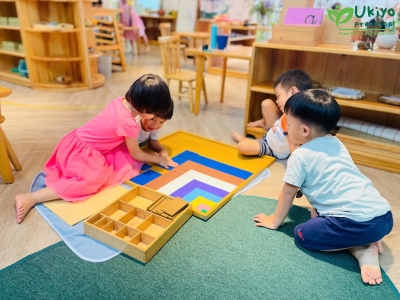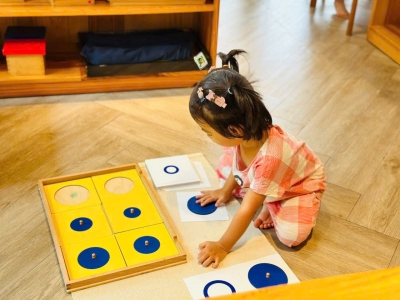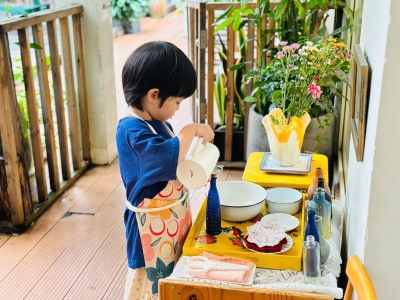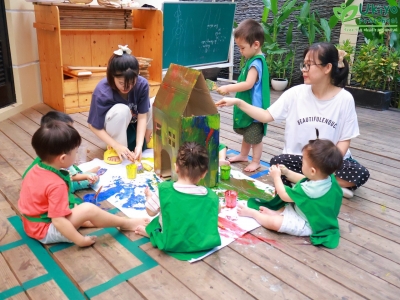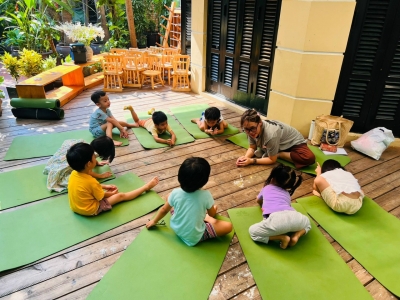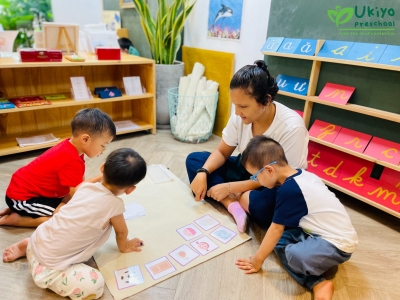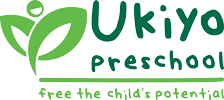TRANSITIONS
Judith A. Orion
I am often queried about the optimal time to move children from the Infant Community to the Primary class. It is a questions raised in schools, raised by parents, and questioned particularly by the Primary class directress. Over the years I have seen many children held too long in an Infant Community only to watch these “normalized” children regress into deviated states and then be deemed “not ready” for the move to the Primary class.
How best can we prepare teachers and parents to anticipate the move and be open to this transition when the child is ready, not when the administration or teachers are ready?
Like all transitions, when a preparation is planned for, when the child’s behavior is observed closely, when we can take advantage of a flexible transition policy which allows children to move when they need to, the transition usually goes without much fuss or angst. This presupposes that the parents and the teachers involved are fully prepared for the transition prior to its beginning.
If we remember that the child at the end of the first sub-plane of the first plane of development is exhibiting signs of the transition from the unconsciously functioning absorbent mind to the consciously functioning absorbent mind, we can observe definite physical, social, cognitive changes in the child.
These “signs of readiness” are easily observable by someone who knows the child well, who can observe subtle changes in behavior.
-
We observe concentrated cycles of activity in the child, especially in the longer practical life exercises.
We know that the child constructs himself through his own independent work. We also know for children this age, that the practical life activities and those activities involving language materials are THE materials in the I.C. that engender concentration, prolonged cycles of activity and interest. The practical life activities, in particular, are those needed to be done, BY THE CHILD, to begin to eliminate those budding psychic deviations. We know that it is the child’s own work that aids that subtle moved from the unconscious to conscious absorbent mind.
-
The child’s level of spoken language has noticeably advanced and the child frequently engages in conversation with friends at meals or in group activities.
-
There is repetition in the use of nomenclature cards; for example, a child works with cards, giving the names to another or repeating a lesson given to her.
-
The child demonstrates a higher level of independence and lower level of mess during lunch and/or snack.
-
The relationship to toileting may not be 100% independent but needs to be on its way to mastery. If the child is not wearing underpants yet but is ready otherwise, the transition is dependent on the Primary directress’s decision or a further dialogue between the adults involved. When parents put children in paper diapers from birth and continue to use them once the child is walking and perhaps interested in using the toilet, the entire process is often delayed. The result is usually a child who is detached from her bodily functions; this child may take even longer to independently use the toilet. When we delay the transition into the Primary class, due to a delay in “toileting readiness” we are, in essence, punishing the child because of a situation created by the adults in the child’s life. We ask a child to put her intellect “on hold” until she chooses to use the toilet and use it independently. The timing of this usually coincides with a psychological stage known in traditional literature as the “opposition crisis”; we refer to this crisis as the “crisis of self affirmation.” The child’s favorite word during this crisis is “NO.” To insist on using the toilet during this time often results in temper tantrums, at worse, and extreme manipulations by the adults, at best.
From my experience, if we simply allow the child to begin the process of transitioning to the Primary class, where everyone uses the toilet independently, putting the child in underpants, the child will simply begin doing what everyone else does in this environment. It may take a few weeks, but if we trust the innate wisdom of the child, we know that if we do not manipulate the child, give the toileting over to the child, the child will come around and choose to use the toilet as everyone does.
• The child demonstrates a social awareness of other children and is comfortable in an environment interacting with ten or twelve others. With the increase in spoken language abilities, we see an increase in social awareness and a desire to communicate with others about their work.
The transition needs to be flexible to meet the needs of each individual child. The Infant Community directress invites the Primary directress to observe the child for at least a half-hour. They function as a team in preparing the parents for this next developmental move to an environment with larger numbers of children (25-35) and a three-year age span. It is as hard for parents to envision their child in this expanded environment as it was for them to watch their child go from the two adults: 1 child ratio of the home or the one adult: 3 babies ratio of the Nido to the two adults: 10-12 children ratio of the Infant Community.
The first step is, as was done prior to the entrance to the Infant Community, a home visit from the new teacher and possibly a “preparation” parent conference with both teachers and the parents. The parents will also observe the Primary class and be given time to formulate and ask questions and voice concerns about the change. They need to be aware of the basic differences between the two environments:
-
The infant community usually communicates daily with the parents; this is not a possibility in the Primary class.
-
The Primary classroom has perhaps four times the material of an Infant Community and the expectation for the level of work and concentration will increase.
-
Some activities in the Infant Community are group activities, or become group activities, and take up much of the morning, e.g., language activities, some food preparation, snack.
In many Primary classrooms food preparation is individual work, and snack is eaten with an invited companion. It takes the children time to adjust to this change. The idea of needing to be invited to join someone’s work may be new to the transitioning child.
The Infant Community directress takes the child for a visit to the Primary class to point out similar materials and familiar children.
Most of us already have some flow throughout the school, with the Infant Community children taking compost to the worm bin, or paper clippings for animal bedding or gluing exercises to the Primary class; so there is some familiarity with the primary directresses and classrooms.
One could also take a “community” walk with the Infant Community children to peek into the rest of the school. One I.C. directress I know keeps little books and language cards of some of the primary materials as language materials, thereby familiarizing the toddlers in the names of some of the materials they will encounter.
After this initial visit the child may make several short, or long visits, depending on the child. An older child may serve as a mentor, going to invite the younger to visit the class or offering to “teach” early sensorial lessons or vocabulary cards. The Infant Community child can be invited to join the Primary class on the playground. The celebration of the “real move” could involve formally moving the child’s belongings from the cubby in one room to the other.
In keeping with our philosophical stance of being ready to “discover the new child each day,” when the Infant Community directress passes on the child’s records, she needs to emphasize the lessons given and mastered not the child’s behavior. These children are ready for challenging practical life lessons, sandpaper letters, early sensorial work and vocabulary enrichment cards when they enter the Primary class. They may be the “baby” of this class, but they have much experience in self-care and independent work already behind them. If the child is presented with lessons she has been doing for some time, her needs will not be met and the child will show signs of regression. If the class “tradition” is to begin the morning with a class lesson (hopefully not!), this young child, ready to work, may also show behaviors labeled “naughtiness.”
HOLDING PATTERNS
The child should move to the primary class when he is ready. “Holding patterns” are not the ideal situation for the child or the Infant Community. School administrators need to cooperate with the directresses and families to work out the logistical and financial aspects of these transitions. I realize that there are times, at the end of a school years, when a transition is not possible. However, to keep a “ready” child in an Infant Community for more than a month is not advisable.
We do know that the child can only construct herself in an environment that meets her developmental needs. An environment which does not satisfy those developmental needs is one in which deviations occur. We see this phenomenon in all the planes of development but development is occurring so rapidly in the first plane that when a child is held too long in an Infant Community, there is a rapid deterioration in behavior. The child who yesterday seemed to be an example of normalization may today, suddenly, exhibit what Montessori called psychic deviations – a deviation from one’s normal path of development. To avoid creating a situation promoting deviations developing, the adults guiding the child and providing an environment for positive self construction must be willing to observe, plan, prepare and allow transition to occur naturally. We must continually ask ourselves: “For whom does the school function: for the needs of the adults or the needs of the child?”
“To assist a child we must provide him with an environment which will enable him to develop freely. A child is passing through a period of self realization, and it is enough simply to open up the door for him.”
Maria Montessori, The Secret of Childhood
Others



